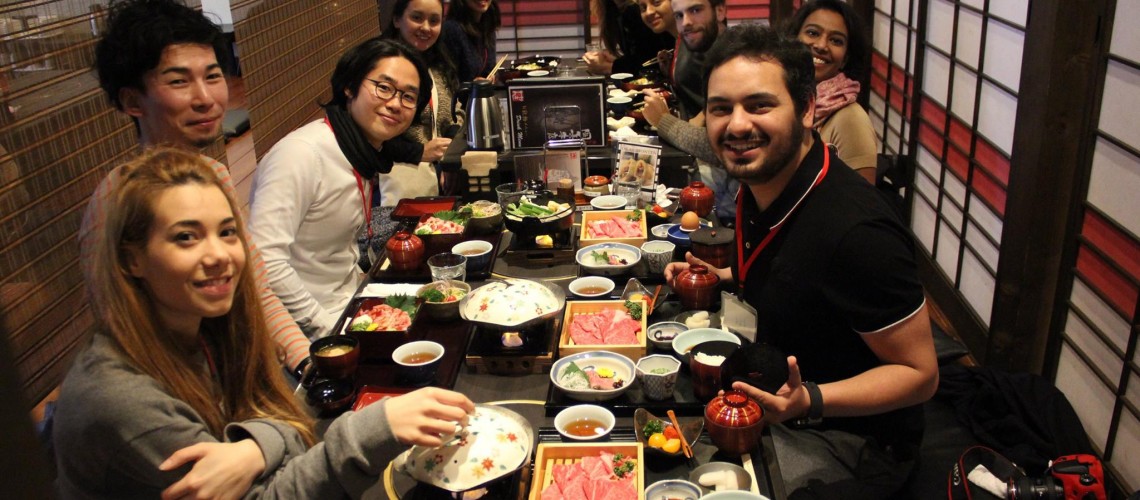
Welcoming our just-landed delegation in Osaka was the Italian Consul General Marco Lombardi who stressed the historically close ties between Japan and Italy, in particular the attraction of Italian-Japanese fusion restaurants such as Sol Levante and the Japanese cult following of Italian products like wine and olive oil. Centuries-old Italian traditions cozied up to typical Japanese cuisines like sushi and ramen and were studied, analyzed and tasted thanks to local partners, academic and non-academics who led the students on this journey of taste beyond stereotypes and preconceived notions of traditional products and how to experience them. While exploring the authenticity of these fundamental foods, the group also immersed themselves in the local atmosphere and discovered local places to experience these foods—far from any Milan sushi bar and truly deep into the atmosphere of this extraordinary country. Among these places was the Nishiki market in Kyoto, the best spot for a “true” taste of sushi and sashimi and to discover numerous varieties of fish. It was also an opportunity to find out how okonomiyaki, “Japanese pizza”, is prepared with a batter similar to an American pancake but made with eggs, water, flour and cabbage, then topped with whatever is desired. Of course, there was also ramen and soba, the spaghetti-like noodle dishes in a hot broth that are so often seen in anime and other Japanese-inspired films.
After Osaka, the Food Innovation Global Mission moved on to Kyoto where they experienced a continuous melting pot of research and innovation. At the Kyoto Institute of Technology, Matteo Vignoli, academic director of the Master and professor in the Department of Science and Methods of Engineering at the University of Modena and Reggio Emilia, led the first Food Innovation Workshop. The students were ignited with design thinking techniques, managerial processes developed by Stanford University that involve the end user and unleash creativity by establishing goals and going through prototyping and testing of proposed solutions. The students, joined by international experts, evaluated ways to research new solutions for better products, services, and brands within Japan and abroad thanks to the participation of Japanese companies Obubu Tea Farm and Okaki Ohmi Beef Company, both visited by the students.
Obubu Tea Farm is located in Wazuka, a town in the Kyoto Prefecture and specializes in artisan teas of high quality from Aracha varieties. The production of this particular product, which uses all parts of the plant, was described to the students by President of the company Akihiro “Akky” Kita from the middle of the tea cultivation fields. After the explanation on the specifics of cultivation and production of the tea, the students were invited to listen to centuries-old stories as they sat on the ground tasting the tea, as is traditional. “In Japan, it’s amazing to see how much attention to detail is given to each step of the supply chain, from cultivation to consumer,” says Matteo Vignoli. The challenge launched by the President for the students was that to create a community of tea-lovers, thus bridging the gap between producers and consumers by facilitating the dissemination of knowledge and market of this historic product.
All the food and drink production in Japan seems to be rooted in ancient times, not only for tea but also in regards to meat, as the second company visit to Okaki Ohmi Beef Company proved. Established in Shiga 170 years ago, the company specializes in raising Wagyu, a specific breed of cattle raised for meat rich in unsaturated fats making it particularly tasty, tender and expensive. In fact, this kind of beef is only consumed by the Japanese on special occasions and is eaten both raw and cooked. In addition, depending on where the cattle are raised, they change not only the name but also the sensory characteristics, from the most famous Kobe beef, to Matsusaka, and then Ohmi. The latter is particularly famous for its ancient origins and consumption by the most important figures of ancient society, such as the shogun, or military governor.
After three days of visits, tales, tastes and analysis, the students of the delegation presented their research and projects at MTRL Kyoto, a co-working space for innovators and creatives. More than 100 people participated in the event, asking questions and giving tips and useful suggestions for the future of each presented project. In this highly collaborative space between market and innovation the students were able to meet those who each day work to make true impact, like Sabrina Sasaki of Makers Boot Camp, the most important acceleration program in Japan and one of the most popular among startups and makers that want to produce projects with accessible and efficient technologies. They were also joined by Philip Nguyen co-founder of Gochiso, an innovative application that is revolutionizing the world of Japanese dining.
And this amazing Journey in Japan is only the beginning! It will be followed by visits to Korea, China, and finally Singapore before their scheduled return to Italy in mid-March.
Follow this amazing lifetime experience “live” on Facebook, Twitter, LinkedIn, YouTube and Instagram using the hashtag #FIGM17
© 2015 Food Innovation Master Degree | © 2014 FUTURE FOOD INSTITUTE
